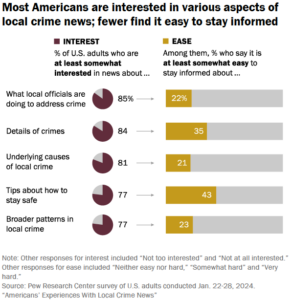People consume a lot of local crime news, but they cannot find the news they need, according to a new study just released by Pew Research.
Those gaps in coverage point to opportunities for local newsrooms to grow their audience by adjusting the way they cover crime.
As part of their Knight Foundation-funded research series on how local news influences civic identity, Pew asked 5,146 people about where they get their crime news and whether they are satisfied.
The respondents told Pew researchers that they get local crime news from two sources: primarily from local news providers, but also from their network of family, friends and neighbors.
While those two sources were by far the dominant methods for receiving crime news, when Pew asked where people turn when they actively want to find out information about local crime, no dominant source emerged.
Just over 25% of people go to local news outlets. And just under 20% said they go to search engines, and the same number turn to social media. Only a handful of people said they rely on local apps like Nextdoor or Ring and even fewer said they turn to local police.
That points to a clear opportunity for local newsrooms to tap into an unmet need. The fact that a dominant go-to source for crime information does not emerge – even though there is so much news about crime in the local news feed – demonstrates that consumers can’t find the information they are looking for.

What did news consumers say they want that they can’t find? Accountability, underlying causes and overall trends.
Among the Pew respondents, 85% said they wanted to know what local officials were doing about crime, yet only 22% found it relatively easy to access that information.
And 81% said they were interested in stories about the causes of crime, but only 21% said they could find that information.
Similarly, 77% said they wanted to know about crime trends and only 23% could easily find them.
For the last three years at Poynter, we’ve guided newsroom teams through a process to alter the mix of their crime coverage to better serve their communities. The course is called Transforming Crime Reporting into Public Safety Journalism. The majority of the 85 newsrooms who have completed our course have embraced two improvements: They report frequently on trends, and they are committed to explanatory journalism focused on public safety.
Ongoing and constant reporting of crime trends
It’s been documented over and over that news consumers are often misinformed about crime trends, believing crime is getting worse, even when it’s improving. That’s because local news is far more likely to devote space to covering specific crimes than it is to reporting on crime trends. This is particularly true when crime is going down.
When newsrooms commit to documenting crime trends on an ongoing basis, they offer audiences easy access to satisfy their curiosity about whether crime is rising or falling. It takes some effort in the beginning, when trying to track crime trends. Because federal data lags by 18 months, journalists have to work with local police, academics and state agencies to get more up-to-date data. This requires developing a method for gathering numbers every month or every quarter, and then presenting them in a way that is easy to digest.
ABC Action News in Philadelphia completed our course in 2023. That station maintains this crime tracker page and references the data in almost every crime story it reports. Here’s what I like about this page.
- The page tracks the homicide rate by neighborhood
- It tracks raw homicide numbers and the homicide rate over time
- It offers perspective on the leading causes of death in Philadelphia
Explanatory and accountability journalism
Explanatory news reporting often starts with a simple question and leads to public accountability. We encouraged newsroom teams to pursue the answers to interesting questions like:
- How many police officers serve our community? How has that changed over time?
- How has our juvenile justice system evolved in recent years? Is the number of arrested children going up or down?
- Which crimes are the hardest to solve?
Here are some questions that led to some of our favorite public safety accountability reporting.
- Why are so many children arrested in Rutherford County, Tennessee?
- Why does this one small city in Texas have so many police officers?
- How many people get traffic tickets in one small Alabama town?
- Why is there no standard way to report heat deaths in Arizona?
More opportunities for better reporting
The Pew study confirms what every local website editor, news director and social media specialist already knows: That Americans really care about crime news. By paying attention to the nuances of what people are really looking for, newsrooms can deepen their connections to their audiences and even broaden their reach.
Here are some additional findings and opportunities:
- Three-fourths of all Americans regularly talk to their friends and family about crime. Giving them journalism that includes explanations and trends will give them more fodder to discuss your newsroom’s work, and more material for your company’s marketing team to enhance your brand.
- Among 18-29 year-olds, 28% have made a social media post about crime. Given that this age group is least likely to consume news from a traditional local newsroom, creating and sharing informative public safety content on social media is an opportunity for newsrooms to build relationships with this cohort.
- Black Americans consume local news at higher rates and are more likely to see news about violent crime. Reporting public safety stories that give voice to Black community members will likely lead to stories that explore causes and solutions.
Pew senior researcher Kirsten Eddy told me that crime is among the most consumed topics when people are getting local information. And there is a relationship between how much crime news people ingest and how fearful they are. But it’s not clear if consuming stories about crime makes people fearful or if scared people consume more crime news.
Crime news also brings out strong, negative emotions in news consumers; 79% of the respondents said crime news made them concerned, and 71% said crime news made them angry.
Eddy said she found that people are less likely to say they feel motivated to change things or to feel confident that things will improve.
All this data about audience attitudes toward local crime news point to a clear strategy for newsroom leaders. You’ll grow your audience and strengthen your news product if you improve your crime coverage. Give people regular stories about crime trends, law enforcement accountability and insight into causes and solutions, and they will come back for more.







